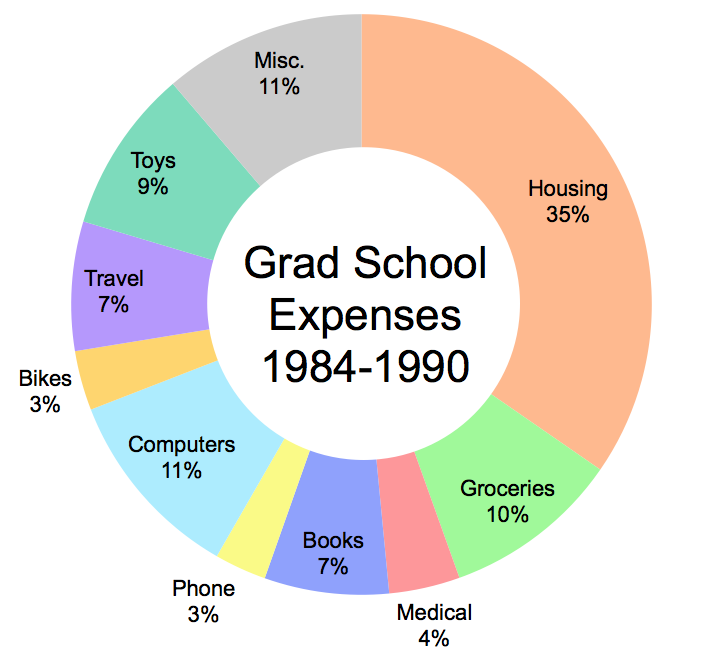Besides, how could anyone get rich by going to grad school? Even if, as in my case, you have teaching and research assistantships that pay your tuition plus a stipend, that stipend is far less than what a college graduate “should” be earning.
And yet, as a side effect, grad school made me rich. It did so partly by enabling me to get good-paying academic jobs ever since. But far more important was the way grad school taught me how to happily live on a grad student’s stipend.
I’ve come to appreciate this fact so much that I went back through my old check registers and credit card statements, to see in detail how I did it. My average annual stipend while in grad school, from 1984 to 1990, was about $12,000 (less for the first couple of years and more later on, after I got a research assistantship). Meanwhile, my annual expenses averaged only about $10,500, so I actually accumulated a five-figure bank balance over those six years. (The consumer price index has approximately doubled since then, so double these numbers to convert to today’s dollars.)
Here’s a breakdown of where that $10,500 went:
I kept my other expenses down by eating home-cooked meals (my roommates and I usually took turns cooking dinners) and by not owning a car (a choice that put me in the minority among my classmates).
These savings freed up substantial sums to spend on extravagant luxuries: more books than I would ever make time to read; two Macintosh computers that allowed me to work from home much of the time; a $900 Miyata touring bike; all sorts of other “toys” including backpacks, tents, other outdoor equipment, two nice pairs of binoculars, a telescope, and a new camera; and roughly two trips a year back east to visit family and friends. (The “miscellaneous” category in the chart includes small amounts for clothes and household items, but consists mostly of cash expenditures that I didn’t keep track of, probably including some groceries, plus occasional restaurant meals, concerts, movies, and cash spent while traveling.)
The fact is, I could have lived on 30% less if I’d had to. Or I could have blown that discretionary 30%, and more, on rent or cars or eating out, and ended up feeling like I had no spending money at all.
I did enter grad school with several advantages. My student loans from college totaled only $4500, with payments and interest deferred until after I was out of school. My parents never spoiled me with big-ticket gifts or large sums of cash, but they did make sure I got started with enough clothes and kitchen utensils. My health was always very good, and health insurance (my only significant medical expense) was cheap back then.
The moral of the story, for today’s grad students and anyone else who’s interested, is simple: Minimize your major expenses (housing, meals, transportation), try to avoid other expensive habits (smoking, drugs, debts, children), and you can live extremely well on a graduate student’s stipend.
After I got my degree my take-home pay instantly doubled, and it has continued to rise steadily ever since. But my expenses remained flat, because I was already living an extravagant lifestyle and never had the least desire to spend more. My spending shifted away from books and outdoor toys, since my need for those things was pretty much saturated. I spent less on computers as their prices dropped. I bought a used car in 1991 and bought one and a half new cars (a massive extravagance) more recently. I eventually bought a house, and quickly paid off the mortgage, so my biggest housing expenditures are now for major maintenance and upgrades. I still ride around town on my Miyata touring bike, and I still prefer home-cooked meals to eating out.
My current living expenses, as near as I can figure them, look like this:
The “miscellaneous” category in this chart includes clothes, household items, books, subscriptions, toys, entertainment, and bike accessories. I’ve tried to average big-ticket expenditures, like car purchases and home improvements, over a suitable number of years. And I’ve mostly tried to separate my own expenses from those of my better half, which isn’t too hard since she has her own financial accounts and her own house.
And where does the rest of my income go? Three places: income tax, savings, and donations to a long list of good causes that I’m proud to support. I won’t detail the breakdown among these three categories, but with a little arithmetic you can safely infer that I could have afforded to retire years ago. I’ve become wealthy without ever trying, and, although I know everyone’s situations and priorities are different, I hope my example can help others do the same.
[For more advice on living a happy life on not much money (or “financial freedom through badassity,” as he puts it), I highly recommend Mr. Money Mustache.]



